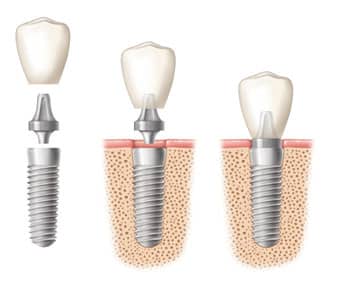
A dental implant is a made up of a titanium (or zirconia) post which replaces your tooth root and is surgically placed into the jawbone beneath the gum. This allows your dentist to fit a replacement tooth (or crown) or a bridge to replace the missing tooth/teeth or gaps in your mouth. As the implants are fixed or “fused with the jaw bone”, they do not need to be removed daily and don’t come loose like a denture. They also do not need to be anchored to other teeth like bridges and hence do not put pressure on, or compromise the oral health of, the remaining teeth.
Types of Dental Implants
Endosteal dental Implants
These are the most common implants, shaped like screws that are fixed into the jaw bone. These screws, or posts, replace the natural teeth roots of the missing teeth that artificial teeth (crowns or bridges) are then fitted on to. Most of these implants are made of titanium or zirconia that bonds into the bone as the bone heals.
Endosteal implants are suited to most patients providing there is healthy jawbone for the implant post to fuse to.
Subperiosteal dental implants
These are made of metal framework that sits below the gum tissue but above the jaw bone. When the gum heals, the artificial teeth are fixed onto posts that protrude from the gum.
Historically, these types of implants have been considered for patients who do not have sufficient jawbone or who may be unwilling to have more bone added (with bone grafting or augmentation) for an endosteal implant. Nowadays, these types of implants are not very common because advances in implant dentistry are such that we can make use of either shorter implants which function just as well as regular implants or different bone grafting techniques (or donor bone) to add more bone.
Dental implants techniques
Depending on the jawbone and the specific needs, there are different options for the placement of dental implants.
Conventional Dental implants
Conventional dental implants have a diameter of about 3mm to 6mm in width. Following the removal of any tooth, a healing period is required. The implant therapy involves a periodontist carrying out a surgical procedure to place a titanium fixture, or post, into the jawbone, with the implants left to heal and integrate with the bone over about a 3-month period. Once the fixture is fused to the bone (osseointegrated), a small abutment is attached into the implant that acts as an anchor to which the artificial tooth, or crown, can attach.
Immediate Dental implants
Immediate dental implants can mean those implants that can be placed at the same visit as the removal of the natural tooth (this is called immediate implant placement) or this can mean immediate load dental implants. Immediate load dental implants are also called same day implants or teeth in a day or 3 days, where the new tooth/set of teeth are placed shortly after the implant posts are placed into the bone. This is an attractive option for patients who have enough healthy natural bone and an implant post secure enough to support the load from an immediately placed tooth on top. The tooth that is fitted soon after surgery is temporary and is designed in such a way to avoid putting too much stress on the healing implant. Once the implants are fully osseointegrated, the temporary teeth will be replaced with a permanent tooth.
Mini dental implants
Mini dental implants are much smaller in diameter, about 1.8mm to 2.9mm. Mini implants have been suggested cases where there is insufficient bone width in the jaws to receive regular-sized implants. These are commonly used to support dentures or replacing small front incisors.
Mini ortho implants (miniscrews implants)
These mini implants are specifically designed for orthodontic anchorage purposes, providing stable “anchors” to support the desired tooth movement. These are about 1.8mm in diameter and provide temporary anchorage and are removed once the desired tooth movement is achieved.
All-on-4 or Teeth in 3 Days
This technique makes use of four dental implants, placed in available bone, to support a complete upper or lower bridge. Special abutments are used so that temporary teeth can be placed on the same day. Again, once the implants are fully osseointegrated, the temporaries will be replaced with permanent teeth. In selected cases where a patient does not have enough jawbone, zygomatic implants may be placed. These implants make use of the cheekbone rather than the upper or lower jaw bone as the implant base.
